Strength Prediction of Non-Sintered Hwangto-Substituted Concrete Using the Ultrasonic Velocity Method
Abstract
1. Introduction
2. Experimental Procedure
2.1. Experimental Plan
2.2. Materials
2.3. Mix Proportion, Casting, and Curing of Specimens
2.4. Test Method
3. Results and Discussion
3.1. Mechanical Properties on Plain Concrete and NSHC by Age
3.1.1. Unit Weight
3.1.2. Compressive Strength
3.1.3. Ultrasonic Pulse Velocity
3.1.4. Stress–Strain Curve
3.2. Microstructural Analysis of Plain Concrete and NSHC
3.2.1. SEM
3.2.2. XRD
3.3. Result of Regression Analysis
3.3.1. Regression Analysis of Plain Concrete and NSHC
3.3.2. Error Test with Previous Research
4. Conclusions
- Although the plain specimen achieved the target compressive strength at all W/B ratios, NSHC did not achieve the target strength in all cases. By the 28th day, NSHC41-15 demonstrated only a decrease of approximately 8.5% in strength compared to plain concrete, while NSHC33-15 displayed an about 8.2% decrease and NSHC28-15 showed an approximately 14.4% decrease. These results suggest that an optimal NSH substitution rate is approximately 15%.
- UPV decreased with increasing NSH substitution ratios. However, unlike compressive strength, the difference ratio between NSHC and plain concrete was not significant. At 28 days, all specimens except NSHC41-30, NSHC41-45, and NSHC33-45 exhibited UPV speeds above 4 km/s. According to concrete quality standards based on the UPV range, these are rated as “Good” or higher. Because UPV is propagated through molecular vibrations, it can be inferred that NSHC, containing molecules with a relatively low bulk modulus, exhibited lower UPV than the plain concrete.
- The stress–strain curves displayed similar patterns at the initial phase of aging but demonstrated changes after 3 days. Concrete with high compressive strength displayed low peak strain, indicating a more brittle nature, with the steepest slope curve observed in specimens with high compressive strength W/B ratios.
- SEM analysis revealed that with increasing NSH substitution rates, the number of voids increased and an amorphous matrix structure became more prevalent, interspersed with NSH particles. This structural change contributed to lower mechanical properties compared to the plain concrete. Furthermore, XRD analysis showed that the intensity of kaolinite and mullite peaks increased with the increasing NSH substitution rate, while that of C–S–H gel, Ca(OH)2, and CaO decreased as the NSH substitution rate increased.
- The regression analysis of UPV and compressive strength indicated that an exponential function is the most suitable for the equation predicting the compressive strength for all specimens. Beyond a certain UPV threshold, the compressive strength exhibited a steep increase. Although UPV increases with compressive strength, the rate of UPV increase diminishes for a higher compressive-strength value. The error testing between the predicted and experimental values demonstrated that the lower the compressive strength, the smaller the error. On average, NSHC exhibited an error of less than 10%.
- It was confirmed that the smaller the substitution rate of NSH, the similar the mechanical properties to plain concrete. However, we believe that research on concrete using cement substitutes to reduce carbon should continue. Accordingly, research should be conducted on wide W/B and detailed cement replacement ratios using various materials, including NSH.
Author Contributions
Funding
Institutional Review Board Statement
Informed Consent Statement
Data Availability Statement
Conflicts of Interest
References
- Park, M.R.; Kim, S.H. An Experimental Study on the Bond Characteristic of GFRP Bars in PVA Fiber Reinforced Activated Hwangtoh CoPlainrete. J. Korea Inst. Struct. MaintenaPlaine Insp. 2017, 21, 134–141. [Google Scholar] [CrossRef]
- Lee, C.Y.; Kim, J.H.; Hyung, W.G. Properties of non-sintered cement mortar using non-activated Hwangto. J. Korea Soc. Waste Manag. 2019, 36, 82–87. [Google Scholar] [CrossRef]
- Malhotra, V.M. Introduction: Sustainable Development and Concrete Technology. Concr. Int. 2002, 24, 22. [Google Scholar]
- Feiz, R.; Ammenberg, J.; Baas, L.; Eklund, M.; Helgstrand, A.; Marshall, R. Improving the CO2 performance of cement, part I: Utilizing life-cycle assessment and key performance indicators to assess development within the cement industry. J. Clean. Prod. 2015, 98, 272–281. [Google Scholar] [CrossRef]
- Olivier, J.G.J.; Schure, K.M.; Peters, J.A.H.W. Trend in global CO2 and total greenhouse gas emission: 2017 Report. PBL Neth. Environ. Assess. AgePlainy 2017, 2674, 8–15. [Google Scholar]
- Choi, R.; Kim, K.S. Solving Direction of the Facing Problems in Korean Cement Industry. KCI Concr. J. 2003, 15.1, 6–9. [Google Scholar]
- Kim, Y.H.; Im, J.S.; Yoo, D.H.; Lee, S.J.; Bae, J.S.; Son, Y.M.; Jeon, H.S.; Lee, D.H. Intended national determined contribution (INDC) and longterm strategy for low GHG emission of major countries under the Paris agreement. Natl. Inst. For. SciePlaine 2017, 727, 5–19. [Google Scholar]
- Metha, P.K.; Monteiro, P.M. CoPlainrete-Structure, Properties, and Materials, 2nd ed.; Prentice Hall: Upper Saddle River, NJ, USA, 1993; pp. 113–178. [Google Scholar]
- Li, C.; Li, J.; Ren, Q.; Zheng, Q.; Jiang, Z. Durability of concrete coupled with life cycle assessment: Review and persperctive. Cem. Concr. Compos. 2023, 139, 105041. [Google Scholar] [CrossRef]
- Sevim, O.; Demir, I.; Alakara, E.H.; Bayer, İ.R. Experimental Evaluation of New Geopolymer Composite with Inclusion of Slag and Construction Waste Firebrick at Elevated Temperatures. Polymers 2023, 15, 2127. [Google Scholar] [CrossRef]
- Sevim, O.; Alakara, E.H.; Guzelkucuk, S. Fresh and Hardened Properties of Cementitious Composites Incorporating Firebrick Powder from Construction and Demolition Waste. Buildings 2023, 13, 45. [Google Scholar] [CrossRef]
- Giannotas, G.; Kamperidou, V.; Stefanidou, M.; Kampragkou, P.; Liapis, A.; Barbouti, I. Utilization of tree-bark in cement pastes. J. Build. Eng. 2022, 57, 104913. [Google Scholar] [CrossRef]
- Sung, C.Y. An experimental study on the development and engineering performaPlaine of rice-husk ash coPlainrete. J. Korean Soc. Agric. Eng. 1997, 39, 55–63. [Google Scholar]
- Park, S.J.; Kim, J.H.; Hyung, W.G. Study on strength and durability of alkali activated slag mortar by replacement ratio on metakaolin. J. Korea Soc. Waste Manag. 2015, 32, 70–77. [Google Scholar] [CrossRef]
- Lee, S.S. A Study on the Fluidity Properties and Strength Properties of Non-sintered Hwangtoh mixed with PVA Fiber. J. Korea Inst. Build. Constr. 2010, 10, 49–56. [Google Scholar] [CrossRef][Green Version]
- Rong, B.; Liu, Q.; Mei, G.; Cheng, B. Analysis of Mechanical Properties of Loess with Cement Incorporation Ratio. MATEC Web Conf. 2022, 358, 01042. [Google Scholar] [CrossRef]
- Garakani, A.A.; Haeri, S.M.; Khosravi, A.; Habibagahi, G. Hydro-mechanical behavior of undisturbed collapsible loessial soils under different stress state conditions. Eng. Geol. 2015, 195, 28–41. [Google Scholar] [CrossRef]
- Kim, J.; Hong, J.; Kim, R.; Woo, U.; Choi, H. Development and Application of IoT-based Contactless Ultrasonic System. J. Korea Inst. Struct. Maint. Insp. 2020, 24, 70–79. [Google Scholar] [CrossRef]
- Lehner, P.; Hrabová, K. Relationship of Time-Dependent Parameters from Destructive and Non-Destructive Tests of Structural Concrete. Mathematics 2022, 10, 460. [Google Scholar] [CrossRef]
- Kim, W.; Lee, T. A Study to Improve the Reliability of High-Strength Concrete Strength Evaluation Using an Ultrasonic Velocity Method. Materials 2023, 16, 6800. [Google Scholar] [CrossRef]
- Nam, Y.; Jeong, K.; Kim, W.; Choi, H.; Lee, T. Evaluation on Early Strength Development of Concrete Mixed with Non-Sintered Hwangto Using Ultrasonic Pulse Velocity. Materials 2023, 16, 6850. [Google Scholar] [CrossRef]
- Kim, W.; Choi, H.; Lee, T. Residual Compressive Strength Prediction Model for Concrete Subject to High Temperatures Using Ultrasonic Pulse Velocity. Materials 2023, 16, 515. [Google Scholar] [CrossRef] [PubMed]
- Kim, J.S. Experimental Study on the Mechanical Properties and FuPlaintionality of Mortar Using Loess Powder. Master’s Thesis, ChungNam National University, Daejeon, Republic of Korea, 2010. [Google Scholar]
- Yang, K.H.; Hwang, H.Z.; Kim, S.Y.; Song, J.K. Development of a Cementless Mortar Using Hwangtoh Binder. Build. Environ. 2007, 42, 3717–3725. [Google Scholar] [CrossRef]
- Güneyli, H.; Karahan, S.; Güneyli, A.; Yap, N. Water Content and Temperature Effect on Ultrasonic Pulse Velocity of Concrete. Russ. J. Nondestruct. Test. 2017, 53, 159–166. [Google Scholar] [CrossRef]
- Kim, M.W.; Oh, H.; Oh, K.C. Estimating the Compressive Strength of High-Strength Concrete Using Surface Rebound Value and Ultrasonic Velocity. J. Korea Inst. Struct. Maint. Insp. 2016, 20, 1–9. [Google Scholar] [CrossRef][Green Version]
- ASTM C469; Standard Test Method for Static Modulus of Elasticity and Poisson’s Ratio of CoPlainrete in Compression. Annual Book of ASTM Standards: Philadelphia, PA, USA, 2011; p. 469.
- ASTM C39/C39M; Standard Test Method for Compressive Strength of Cylindrical CoPlainrete Specimens. American Society of Testing and Materials: West Conshohocken, PA, USA, 2018; pp. 1–8.
- ASTM C597-16; Standard Test Method for Pulse Velocity Through CoPlainrete. American Society of Testing and Materials: West Conshohocken, PA, USA, 2016; pp. 1–4.
- Sha, W.; Pereira, G.B. Differential scanning calorimetry study of ordinary Portland cement paste containing metakaolin and theoretical approach of metakaolin activity. Cem. CoPlainrete Compos. 2001, 23, 455–461. [Google Scholar] [CrossRef]
- O’Ferrell, M.; Wild, S.; Sabir, B.B. Pore size distribution and compressive strength of waste clay brick mortar. Cem. Concr. Compos. 2001, 23, 81–91. [Google Scholar] [CrossRef]
- Sabir, B.B.; Wild, S.; Bai, J. Metakaolin and calcined clays as pozzolans for concrete: A review. Cem. Concr. Compos. 2001, 23, 441–454. [Google Scholar] [CrossRef]
- Chalee, W.; Ausapanit, P.; Jaturapitakkul, C. Utilization of fly ash concrete in marine environment for long term design life analysis. Mater. Des. 2010, 31, 1242–1249. [Google Scholar] [CrossRef]
- Özkan, Ö.; Yüksel, I.; Muratoğlu, Ö. Strength properties of concrete incorporating coal bottom ash and granulated blast furnace slag. Waste Manag. 2007, 27, 161–167. [Google Scholar] [CrossRef]
- Jung, Y.; Kim, S.; Lee, D. Properties of Cementless Loess Mortar Using Eco-Friendly Hardening Agent. J. Recycl. Constr. Resour. Inst. 2015, 3, 355–365. [Google Scholar] [CrossRef][Green Version]
- Sung, C.; Ryu, N.; Youn, J. Physical and Mechanical Properties of Mortar Using Non-active Hwangto and Stone Dust. J. Korean Soc. Agric. Eng. 2022, 44, 83–89. [Google Scholar]
- Cho, Y.; Jung, H.; Lee, S.; Song, H. Engineering Properties of Mortar According to the Replacement Ratio of Lime and the Ratio between Non-Sintered Hwangto and Sand; The Regional Association of Architectural Institute of Korea: Seoul, Republic of Korea, 2008; pp. 919–924. [Google Scholar]
- Ohdaira, E.; Masuzawa, N. Water content and its effect on ultrasound propagation in concrete—The possibility of NDE. Ultrasonics 2000, 38, 546–552. [Google Scholar] [CrossRef] [PubMed]
- Hernández, M.G.; Izquierdo, M.A.G.; Ibáñez, A.; Anaya, J.J.; Ullate, L.G. Porosity estimation of concrete by ultrasonic NDE. Ultrasonics 2000, 38, 531–533. [Google Scholar] [CrossRef] [PubMed]
- Agunwamba, J.C.; Adagba, T. A comparative analysis of the rebound hammer and ultrasonic pulse velocity in testing concrete. Niger. J. Technol. 2012, 31, 31–39. [Google Scholar]
- Hwang, E.; Kim, G.; Choe, G.; Yoon, M.; Gucunski, N.; Nam, J. Evaluation of concrete degradation depending on heating conditions by ultrasonic pulse velocity. Constr. Build. Mater. 2018, 171, 511–520. [Google Scholar] [CrossRef]
- Arpajirakul, S.; Pungrasmi, W.; Likitlersuang, S. Efficiency of microbially-induced calcite precipitation in natural clays for ground improvement. Constr. Build. Mater. 2021, 282, 122722. [Google Scholar] [CrossRef]
- Meroufel, B.; Benali, O.; Benyahia, M.; Zenasni, M.A.; Merlin, A.; George, B. Removal of Zn (II) from Aqueous Solution onto Kaolin by Batch Design. J. Water Resour. Prot. 2013, 5, 669–680. [Google Scholar] [CrossRef]
- Heo, J.O.; Lee, J.K.; Hyung, W.G. Properties of Cementless Mortar using Eco-Friendly Inorganic Binding Material. J. Korea Concr. Inst. 2014, 26, 499–506. [Google Scholar] [CrossRef]
- Karimaei, M.; Dabbaghi, F.; Dehestani, M.; Rashidi, M. Estimating Compressive Strength of Concrete Containing Untreated Coal Waste Aggregates Using Ultrasonic Pulse Velocity. Materials 2021, 14, 647. [Google Scholar] [CrossRef]
- Mohanmmed, T.U.; Rahman, M.N. Effect of types of aggregate and sand-to-aggregate volume ratio on UPV in concrete. Constr. Build. Mater. 2016, 125, 832–841. [Google Scholar] [CrossRef]
- Demirboğa, R.; Türkmen, I.; Karakoç, M.B. Relationship between ultrasonic velocity and compressive strength for high–volume mineral–admixtured concrete. Cem. Concr. Res. 2004, 34, 2329–2336. [Google Scholar] [CrossRef]
- Trtnik, G.; Kavčič, F.; Turk, G. Prediction of concrete strength using ultrasonic pulse velocity and artificial neural networks. J. Ultrason. 2009, 49, 53–60. [Google Scholar] [CrossRef] [PubMed]
- Shariq, M.; Prasad, J.; Masood, A. Studies in ultrasonic pulse velocity of concrete containing GGBFS. Constr. Build. Mater. 2013, 40, 944–950. [Google Scholar] [CrossRef]
- Mohammed, B.S.; Azmi, N.J.; Abdullahi, M. Evaluation of rubbercrete based on ultrasonic pulse velocity and rebound hammertests. Constr. Build. Mater. 2011, 25, 1388–1397. [Google Scholar] [CrossRef]
- Zhang, Y.; Aslani, F. Compressive strength prediction models of lightweight aggregate concretes using ultrasonic pulse velocity. Constr. Build. Mater. 2021, 292, 123419. [Google Scholar] [CrossRef]
- Naniz, O.A.; Mazloom, M. Effects of colloidal nano-silica on fresh and hardened properties of self compacting lightweight concrete. J. Build. Eng. 2018, 20, 400–410. [Google Scholar] [CrossRef]
- Kim, W.; Jeong, K.; Choi, H.; Lee, T. Correlation Analysis of Ultrasonic Pulse Velocity and Mechanical Properties of Normal Aggregate and Lightweight Aggregate Concretes in 30–60 MPa Range. Materials 2022, 15, 2952. [Google Scholar] [CrossRef]
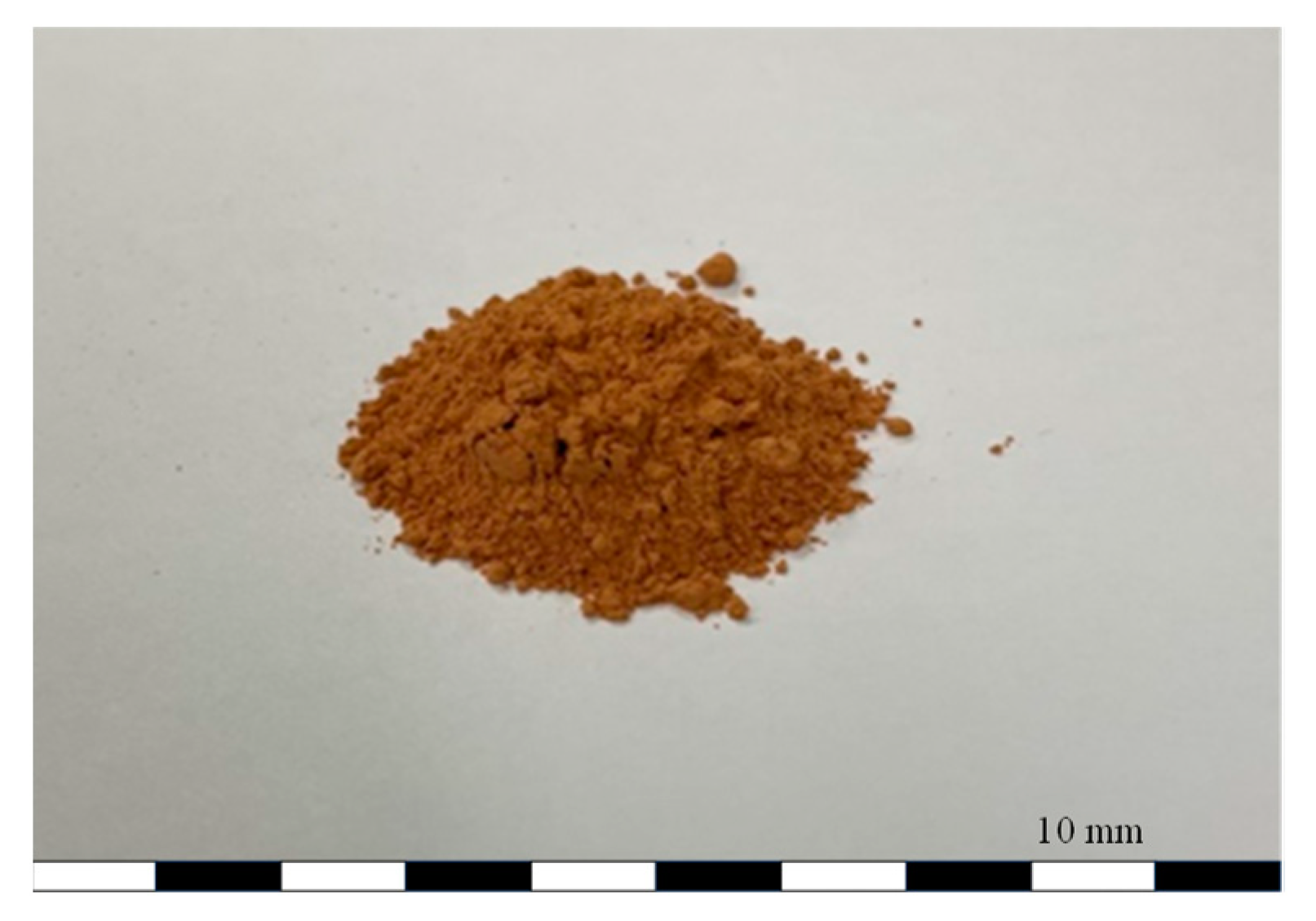
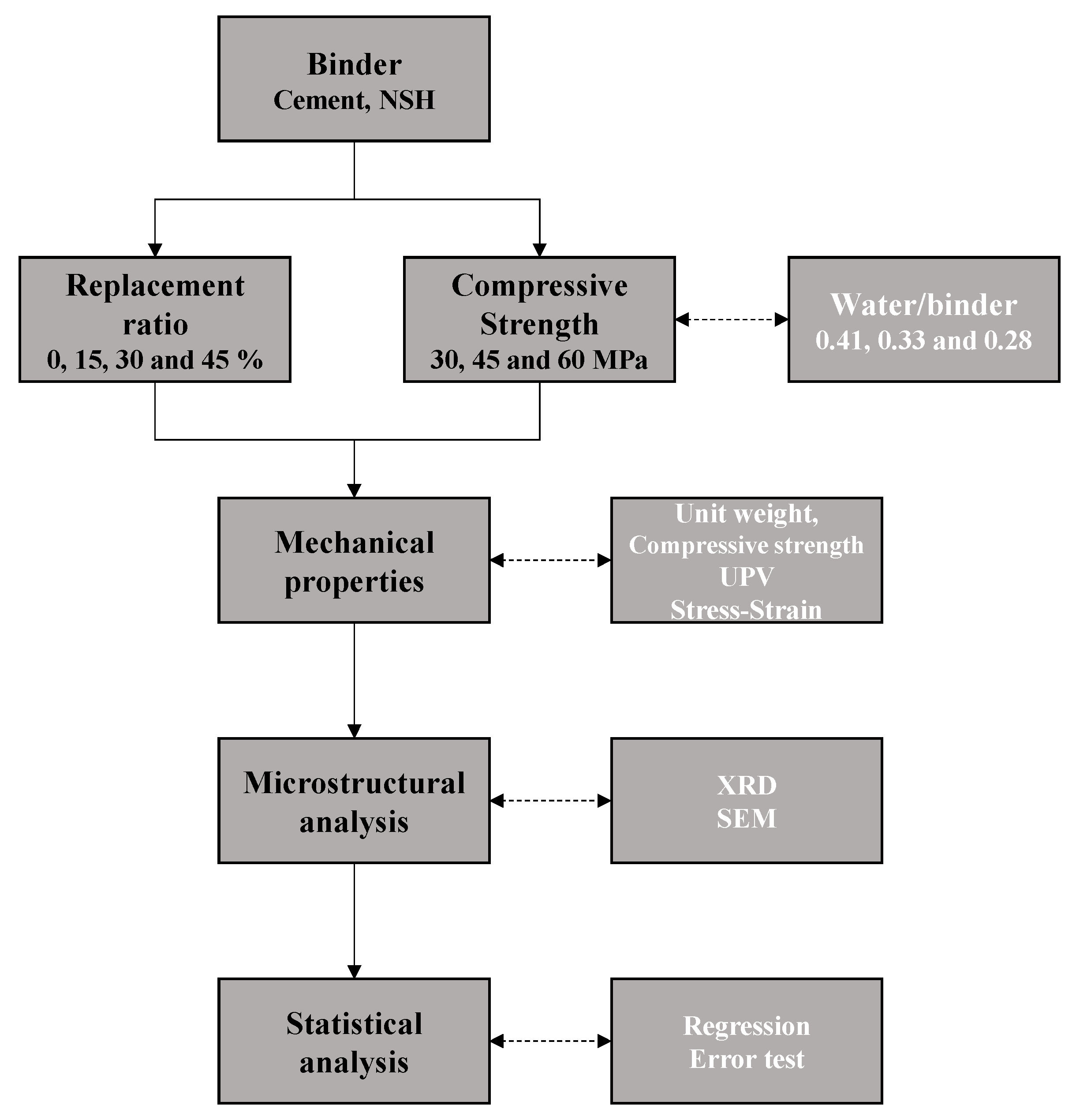
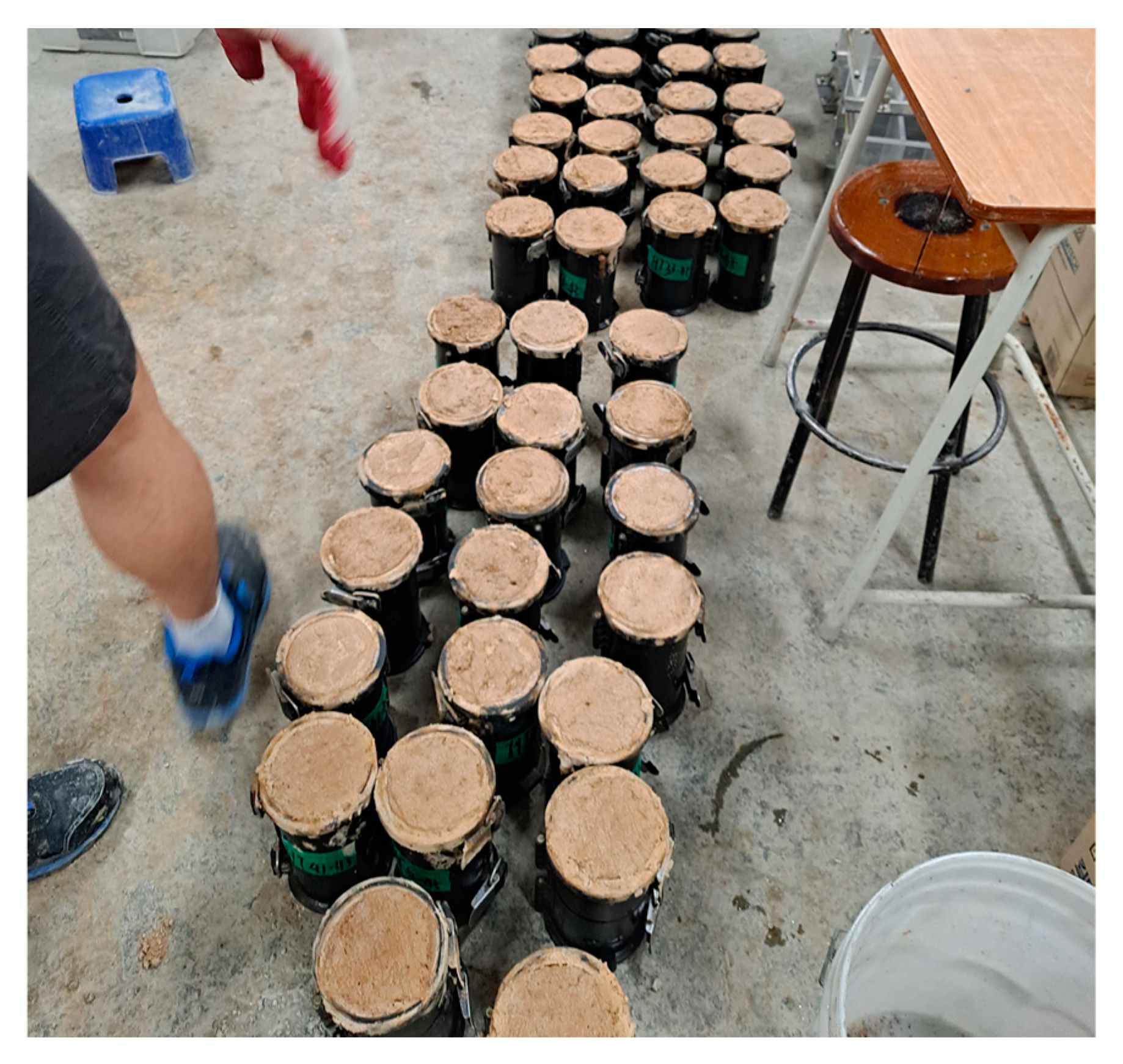
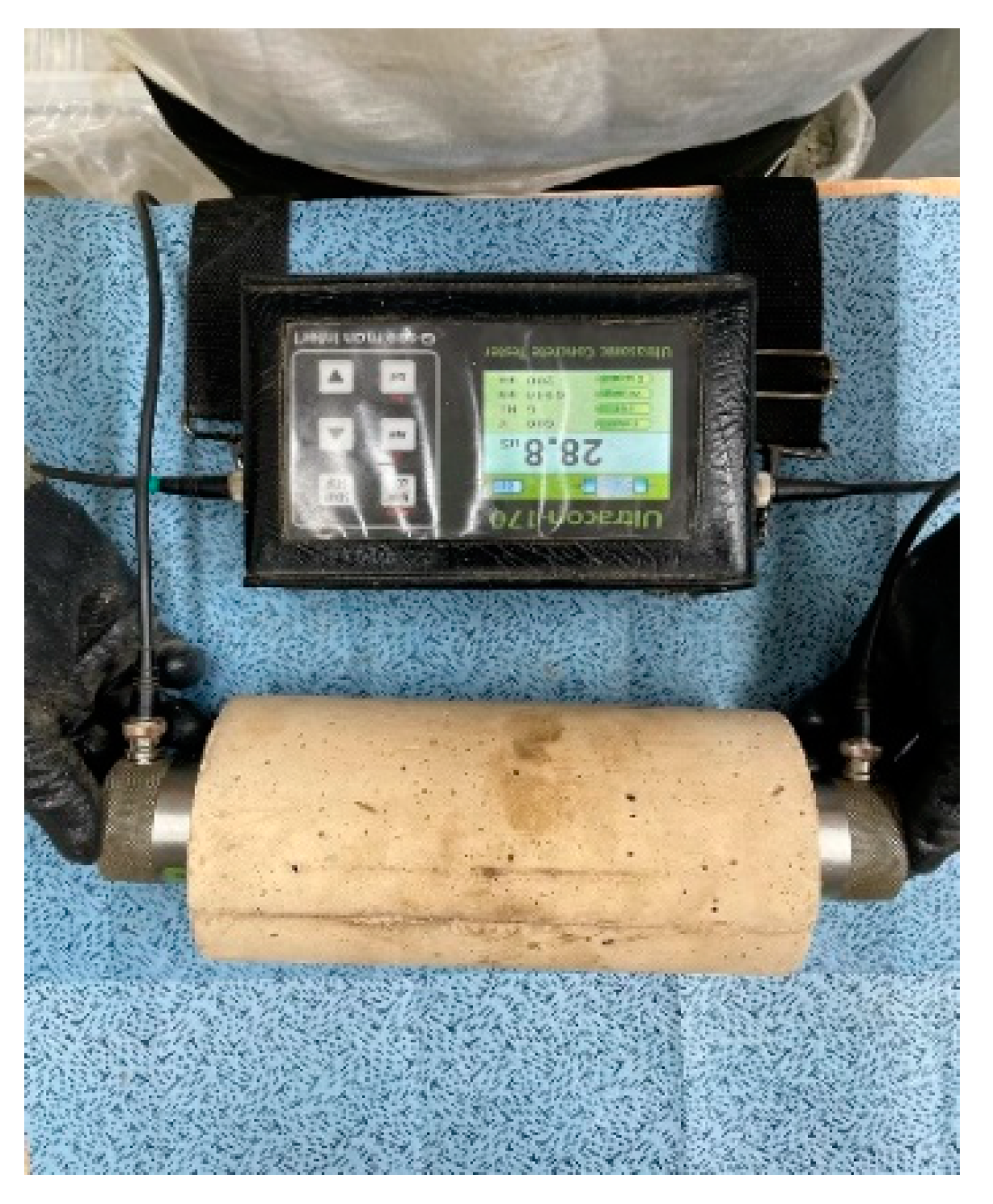
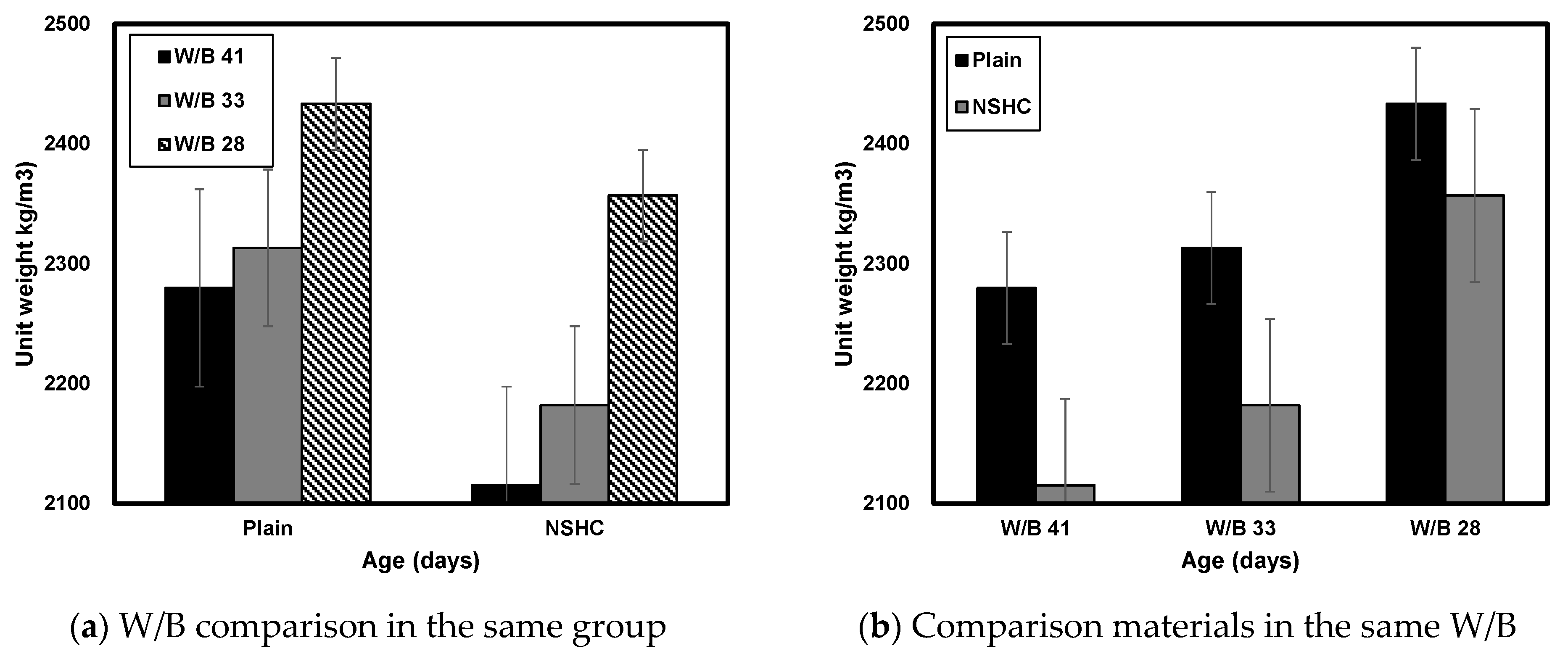
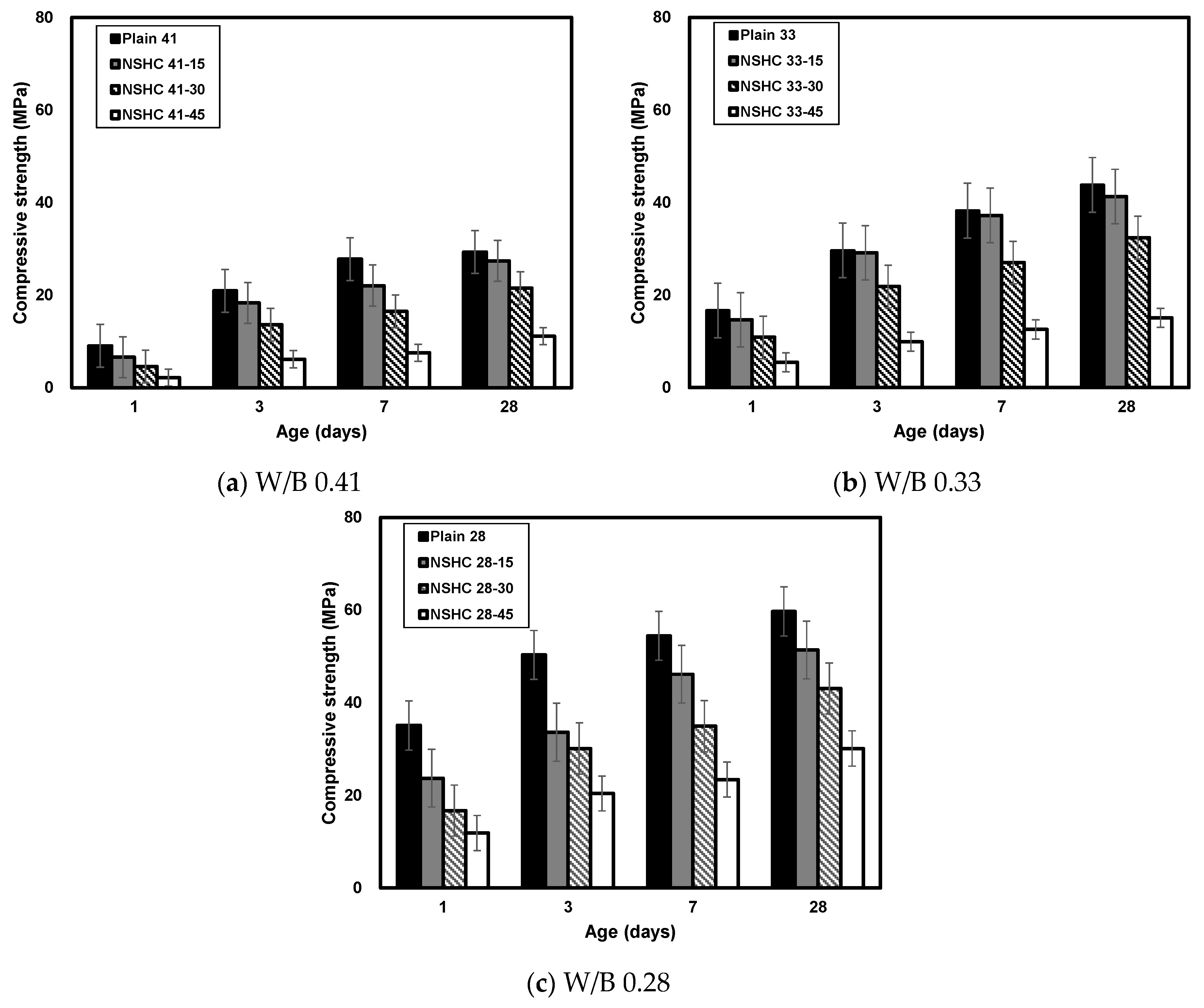
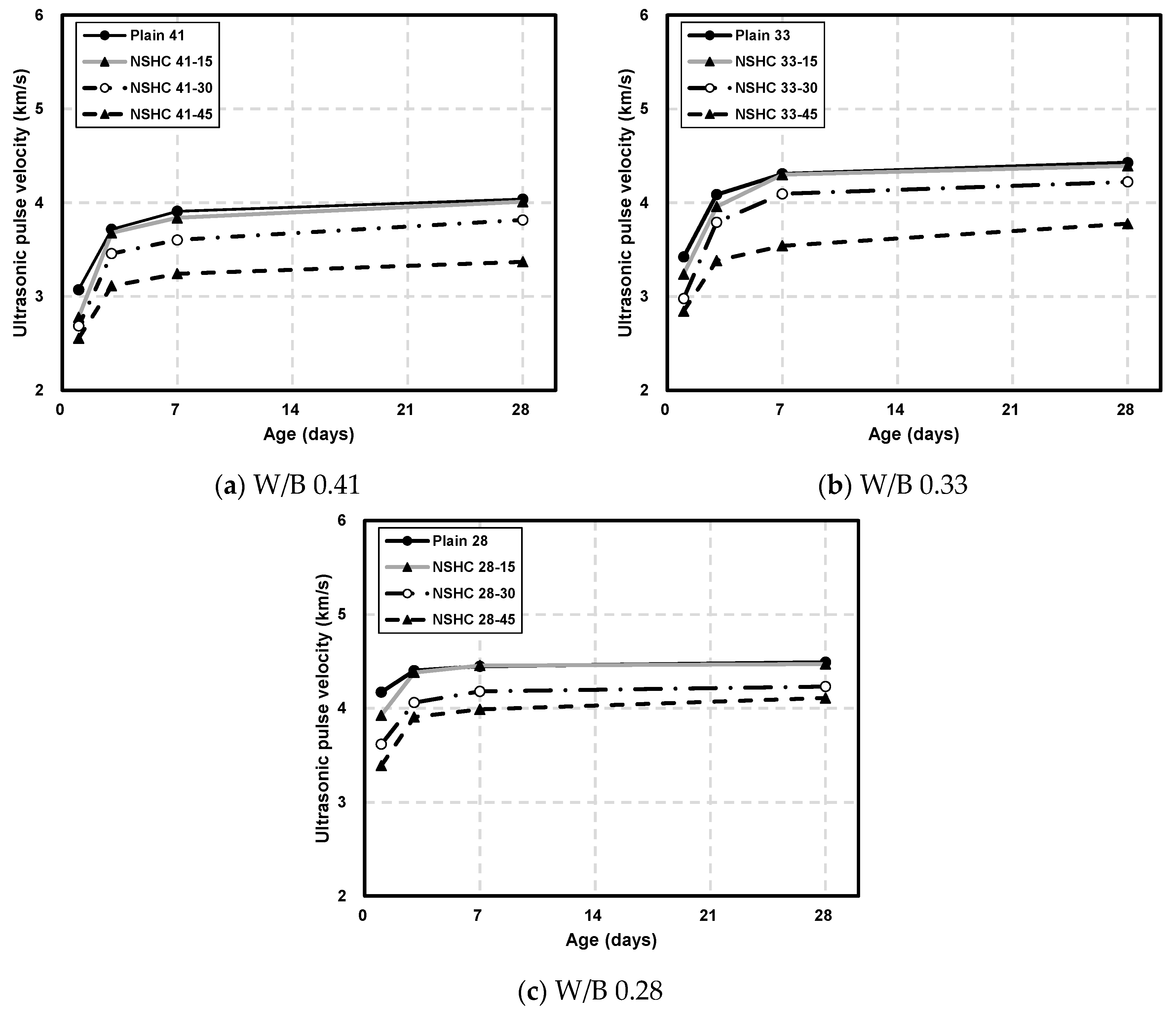


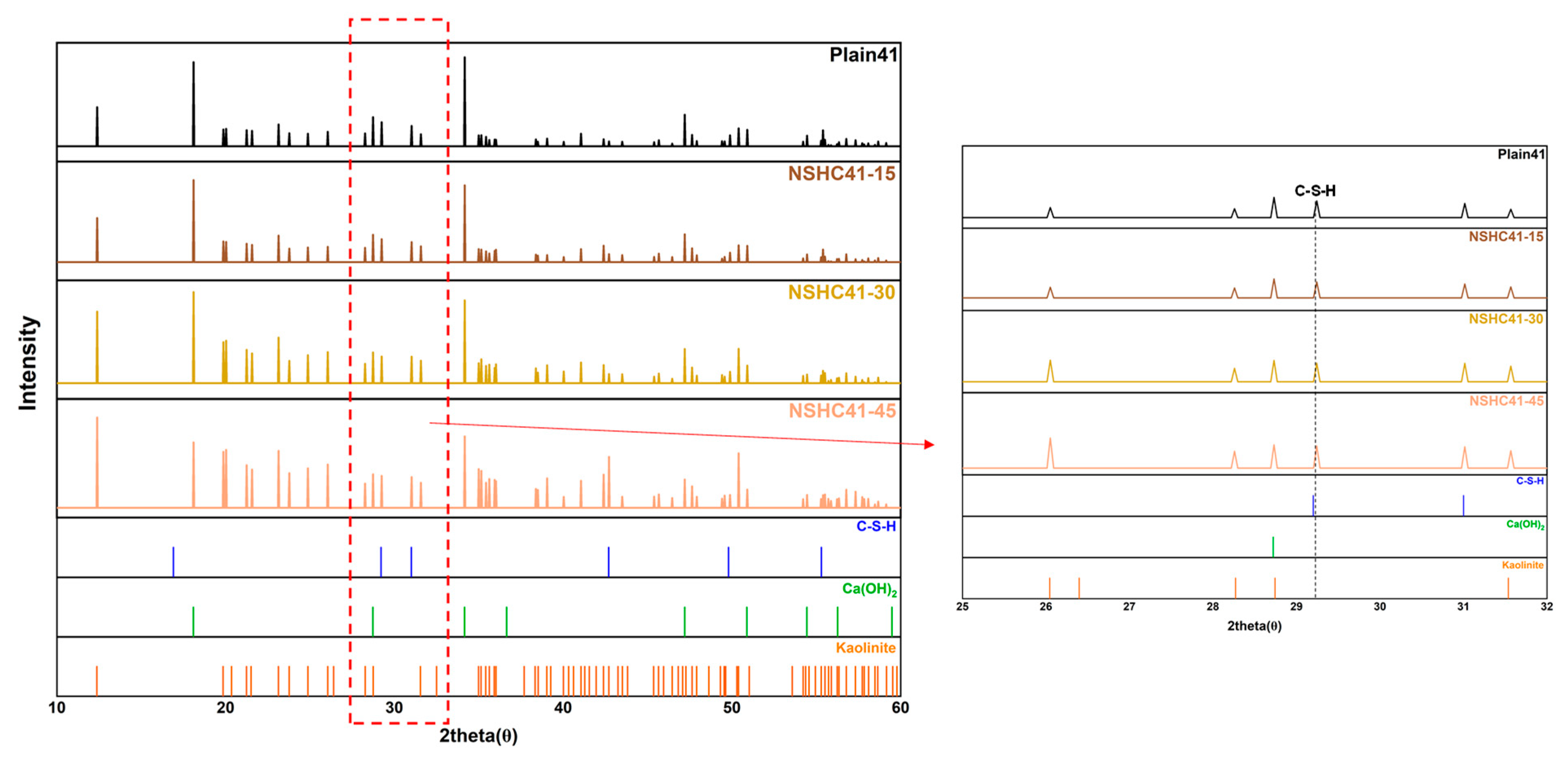
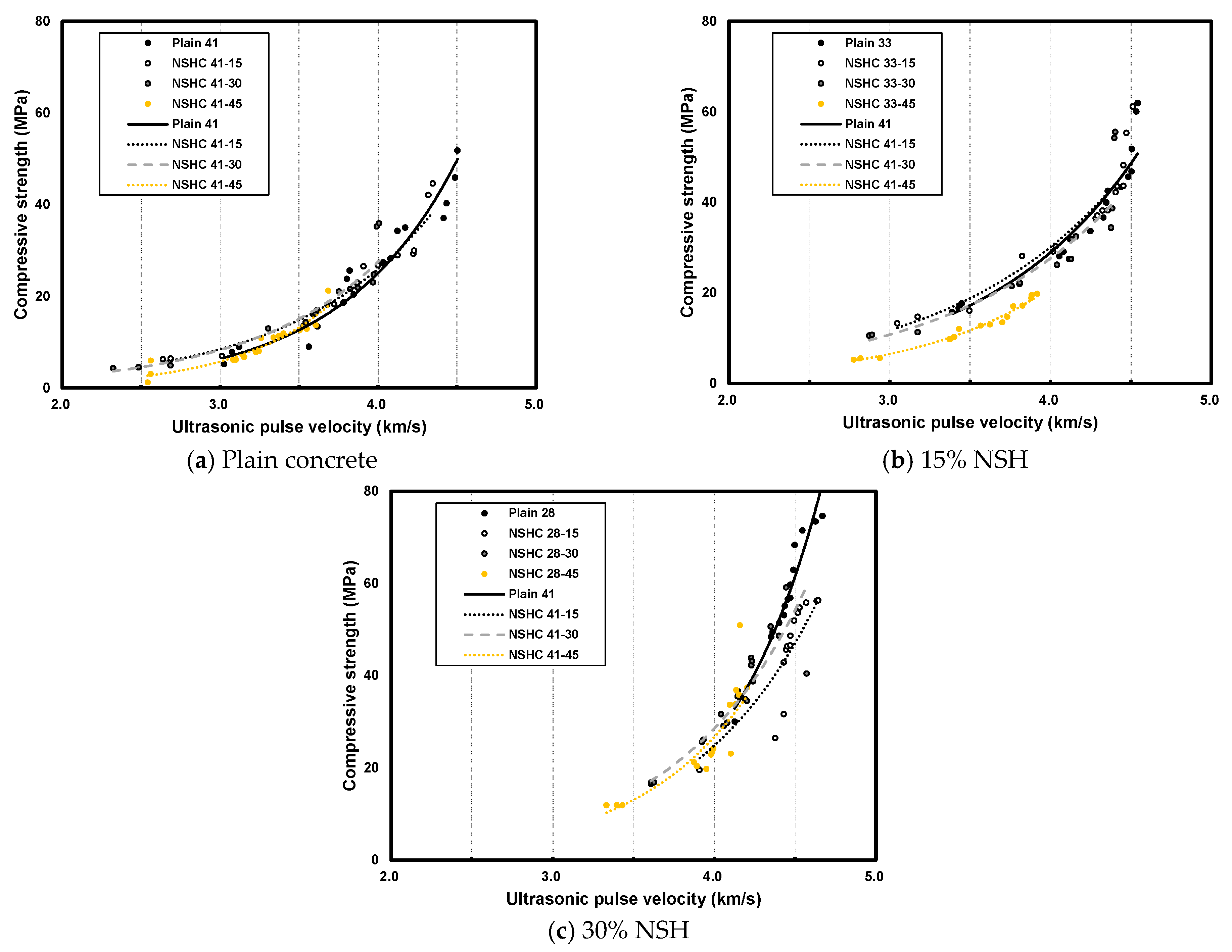

| Materials | Properties |
|---|---|
| Cement | Type Ⅰ ordinary Portland cement Density: 3150 kg/m3 and fineness: 320 m2/kg |
| Hwangto | Non-sintered Hwangto Density: 2500 kg/m3 and fineness: 330 m2/kg |
| Coarse aggregate | Crushed granite aggregate Density: 2680 kg/m3 and fineness modulus: 7.03, Absorption: 0.68% and maximum size: 20 mm |
| Fine Aggregate | river sand Density: 2540 kg/m3, fineness modulus: 2.54, and absorption: 1.6% |
| Materials | Chemical Composition (%) | L.O.I. | |||||||
|---|---|---|---|---|---|---|---|---|---|
| CaO | SiO2 | Al2O3 | Fe2O3 | MgO | SO3 | K2O | Others | ||
| OPC | 60.34 | 19.82 | 4.85 | 3.30 | 3.83 | 2.88 | 1.08 | 0.86 | 3.02 |
| NSH | 0.39 | 40.0 | 32.9 | 7.79 | 1.54 | – | 0.76 | 16.62 | 13.7 |
| MIX ID | W/B | S/a | Unit Weight (kg/m3) | ||||
|---|---|---|---|---|---|---|---|
| W | C | NSH | S | G | |||
| Plain41 | 0.41 | 0.46 | 165 | 400 | – | 799 | 956 |
| NSHC41-15 | 340 | 60 | 794 | 950 | |||
| NSHC41-30 | 280 | 120 | 788 | 943 | |||
| NSHC41-45 | 220 | 180 | 781 | 935 | |||
| Plain33 | 0.33 | 0.43 | 500 | – | 711 | 961 | |
| NSHC33-15 | 425 | 75 | 705 | 953 | |||
| NSHC33-30 | 350 | 150 | 699 | 944 | |||
| NSHC33-45 | 275 | 225 | 691 | 934 | |||
| Plain28 | 0.28 | 0.43 | 600 | – | 676 | 896 | |
| NSHC28-15 | 510 | 90 | 668 | 886 | |||
| NSHC28-30 | 420 | 180 | 661 | 876 | |||
| NSHC28-45 | 330 | 270 | 655 | 866 | |||
| Materials | Properties | Equation (1) |
|---|---|---|
| Compressive strength (MPa) | ASTM C39/C39M | vp: ultrasonic pulse velocity (m/s) : distance (m) : time (s) |
| Strain (σ)–stress (ε) | ASTM C469 | |
| Ultrasonic pulse velocity (km/s) | ASTM C597 |
| Range of UPV | Quality of Concrete |
|---|---|
| Exceeding 4500 m/s | Excellent |
| 4000–4500 m/s | Good |
| 3500–4000 m/s | Doubtful/questionable |
| 3000–3500 m/s | Poor |
| Less than 3000 m/s | Very poor |
| Properties | Chemical Composition (%) | ||||||
|---|---|---|---|---|---|---|---|
| SiO2 | Al2O3 | Fe2O3 | CaO | MgO | SO3 | K2O | |
| Density (kg/m3) | 2630 | 3950 | 5190 | 3350 | 3630 | 2340 | 2410 |
| Bulk modulus (GPa) | 29 | 231 | 178 | 105 | 151 | 5 | 27 |
| Poisson’s ratio | 0.00 | 0.24 | 0.31 | 0.21 | 0.19 | 0.31 | 0.27 |
| ID | Exponential | Linear | ||||
|---|---|---|---|---|---|---|
| R-Square | Root-MSE | RMS | R-Square | Root-MSE | RMS | |
| Plain41 | 0.92 | 4.07 | 16.55 | 0.91 | 4.46 | 19.85 |
| NSHC41-15 | 0.88 | 3.90 | 15.22 | 0.83 | 4.69 | 22.01 |
| NSHC41-30 | 0.80 | 4.26 | 18.19 | 0.77 | 4.69 | 21.97 |
| NSHC41-45 | 0.78 | 2.25 | 5.08 | 0.78 | 2.33 | 5.45 |
| Plain33 | 0.90 | 4.48 | 20.03 | 0.84 | 5.97 | 35.65 |
| NSHC33-15 | 0.90 | 4.26 | 18.15 | 0.84 | 5.77 | 33.26 |
| NSHC33-30 | 0.96 | 1.95 | 3.82 | 0.94 | 2.43 | 5.91 |
| NSHC33-45 | 0.96 | 0.99 | 0.98 | 0.93 | 1.32 | 1.73 |
| Plain28 | 0.82 | 5.53 | 30.59 | 0.95 | 3.05 | 9.32 |
| NSHC28-15 | 0.94 | 3.13 | 9.82 | 0.96 | 2.51 | 6.28 |
| NSHC28-30 | 0.87 | 4.66 | 21.74 | 0.90 | 4.14 | 17.14 |
| NSHC28-45 | 0.60 | 6.94 | 48.17 | 0.68 | 6.45 | 41.64 |
| NSHC41 | 0.89 | 3.40 | 11.55 | 0.82 | 4.47 | 20.00 |
| NSHC33 | 0.89 | 4.55 | 20.72 | 0.81 | 6.12 | 37.40 |
| NSHC28 | 0.87 | 5.03 | 25.26 | 0.88 | 4.76 | 22.65 |
Disclaimer/Publisher’s Note: The statements, opinions and data contained in all publications are solely those of the individual author(s) and contributor(s) and not of MDPI and/or the editor(s). MDPI and/or the editor(s) disclaim responsibility for any injury to people or property resulting from any ideas, methods, instructions or products referred to in the content. |
© 2023 by the authors. Licensee MDPI, Basel, Switzerland. This article is an open access article distributed under the terms and conditions of the Creative Commons Attribution (CC BY) license (https://creativecommons.org/licenses/by/4.0/).
Share and Cite
Im, H.; Kim, W.; Choi, H.; Lee, T. Strength Prediction of Non-Sintered Hwangto-Substituted Concrete Using the Ultrasonic Velocity Method. Materials 2024, 17, 174. https://doi.org/10.3390/ma17010174
Im H, Kim W, Choi H, Lee T. Strength Prediction of Non-Sintered Hwangto-Substituted Concrete Using the Ultrasonic Velocity Method. Materials. 2024; 17(1):174. https://doi.org/10.3390/ma17010174
Chicago/Turabian StyleIm, Hajun, Wonchang Kim, Hyeonggil Choi, and Taegyu Lee. 2024. "Strength Prediction of Non-Sintered Hwangto-Substituted Concrete Using the Ultrasonic Velocity Method" Materials 17, no. 1: 174. https://doi.org/10.3390/ma17010174
APA StyleIm, H., Kim, W., Choi, H., & Lee, T. (2024). Strength Prediction of Non-Sintered Hwangto-Substituted Concrete Using the Ultrasonic Velocity Method. Materials, 17(1), 174. https://doi.org/10.3390/ma17010174







